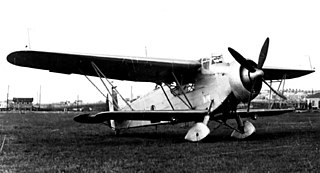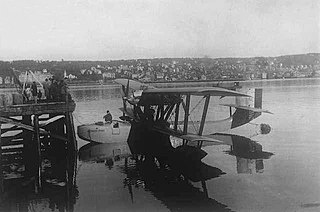
The Avro 549 Aldershot was a British single-engined heavy bomber aircraft built by Avro.

The IMAM Ro.30 was a 1930s Italian observation biplane designed and built by Industrie Meccaniche e Aeronautiche Meridionali. It was only built in limited numbers before being replaced by the Ro.37.

The Farman F.50 was a French twin-engined night bomber designed and built by Farman as a replacement for the single-engined Voisin pusher biplanes in service with the French Air Force.
The Farman F.51 was a 1920s French maritime reconnaissance flying boat designed and built by Farman. The F.51 was an unequal-span four-bay biplane flying boat with a crew of four. It was powered by two Lorraine 8bd engines mounted in tractor configuration. A pusher engined version was designated the Farman F.50 . Tested by the French Navy but it failed to win any orders, Farman did briefly consider a civil version but the project was abandoned.

The Farman F.180 Oiseau Bleu was a 1920s French biplane airliner. The F.180 was designed to fly non-stop between Paris and New York, but when the crossing attempt was cancelled three aircraft were built as luxury transports to operate from Paris to nearby European capital cities for the company's own airline.

The Farman F.70 was a 1920s French passenger and mail transport aircraft designed and built by the Farman Aviation Works. It was a smaller counterpart to the company's popular F.60 Goliath. The F.70 was an unequal-span two-bay biplane with a wooden fuselage and was powered by a Renault 12Fe piston engine. The pilot was seated in an open cockpit behind the nose-mounted engine. Behind the open cockpit was a cabin for four passengers or freight.

The Kawasaki Army Type 88 Reconnaissance Aircraft was a Japanese single-engined biplane designed for Kawasaki by Richard Vogt. Originally known by its company designation KDA-2, it was accepted by the Imperial Japanese Army as the Type 88 Reconnaissance Aircraft. The Type 88 number was designated for the year the aircraft was accepted, 2588 in the Japanese imperial year calendar, or 1928 in the Gregorian calendar. The basic design was modified into the Type 88 Light Bomber that used in combat over China in the Second Sino-Japanese War. The Type 88 was built in large numbers and remained in service until 1940.

The Latham 47, or Latham R3B4 in Naval service was a French twin-engine flying boat designed and built by Société Latham & Cie for the French Navy. The aircraft achieved notoriety in 1928 when aircraft number 47.02 disappeared with the explorer Roald Amundsen on a rescue mission for the Italian explorer Umberto Nobile.

The Lioré et Olivier LéO 7 was a French bomber escort biplane designed and built by Lioré et Olivier for the French Air Force.

The Royal Aircraft Factory R.E.7 was a British two-seat light bomber and reconnaissance biplane designed by the Royal Aircraft Factory and built under contracts by the Coventry Ordnance Works, Austin, Napier and Siddeley-Deasy for the Royal Flying Corps.
The Macchi M.8 was an Italian reconnaissance/bomber flying boat designed by Alessandro Tonini and built by Macchi. It was used by the Italian Naval Aviation and was later flown by crews from the United States Navy.

The Bristol Berkeley was built to a British government specification for a single-engine day or night bomber. Three of these two-seat biplanes were built, but no contract for further production was awarded.

The Farman F.160 A.2 was a 1920s French sesquiplane designed as a military reconnaissance and observation aircraft. Only one was built.
The Farman F.150 was a 1920s French twin-engined biplane designed by Farman as a day bomber.
The Farman F.130 was a 1920s French biplane designed by Farman as a long-range day bomber.

The Farman BN.4, a.k.a. Super Goliath, was a very large 1920s French biplane designed by Farman as a long-range night bomber.

The Douglas XT3D was an American three-seat torpedo bomber biplane developed by the Douglas Aircraft Company to meet a United States Navy requirement.

The Farman F.110 was a French two-seat artillery observation biplane designed and built by the Farman Aviation Works.

The Albatros C.II was a 1910s German military pusher reconnaissance biplane designed and built by Albatros Flugzeugwerke. Only one aircraft was built and the type did not enter production.
The Farman F.30A C2 was a two-seat biplane designed as a fighter in France in 1916 and powered by a single, water-cooled radial engine. It showed poor flight characteristics and only one was built, though it was modified twice. It should not be confused with the similarly named Henry Farman HF.30 of 1915, a completely different aircraft which was used in large numbers by the Imperial Russian Air Service.